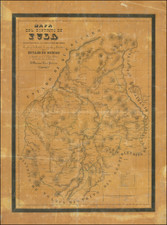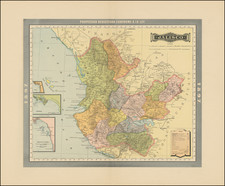Pastoral painting of a hacienda at the foot of the Popocatépetl and Iztaccíhuatl volcanoes
This beautifully painted scene shows a villa and its outlying buildings surrounded by fields. On the horizon looms a mountain range dominated by two snow-capped peaks. These are the legendary volcanoes Popocatépetl and Iztaccíhuatl.
Notes in the lower left corner provide labels for the mountains, but they are also recognizable by their distinct shapes. Popocatépetl is a sharp peak and is farther south, while Iztaccíhuatl consists of a series of peaks and is farther to the north. Thus, this painting is taken from a perspective west of the mountains, looking east.
The paper itself provides further clues about the painting. The page is stamped across the top, indicating it was from an official office that monitored its paper. It is designated for the years 1842 and 1843.
In the lower right corner is a note that says, "S. Agustin de las Cuevas." There is indeed a San Agustín de las Cuevas in the region, a neighborhood of Mexico City known for its religious sites. Perhaps this is a painting harkening back to when the site was a mere village, or maybe this is supposed to be a farm near the original village. By the 1840s, the area was populated and urban.
The most distinguishing feature of the painting, the snowy volcanoes, has an interesting story. Iztaccíhuatl is Nahuatl for "white woman", a name garnered from the four snowy peaks of the mountain that represent the woman's head, chest, knees, and feet. According to Aztec mythology, Iztaccíhuatl, a princess, fell for a warrior, Popocatépetl. Iztaccíhuatl's father sent the warrior to war in Oaxaca. He promised the brave fellow his daughter's hand, but only because he assumed the soldier would not return. When Popocatépetl did return, he found his beloved dead. She had been told her love died in battle and she then died of grief. Popocatépetl took Iztaccíhuatl's body to be buried outside Tenotitchitlan, where the gods changed their bodies into mountains and covered them with snow. Popocatépetl became an active volcano, exploding to reign fire on the ruler who tricked him. In fact, Popocatépetl remains Mexico's most active volcano. It has had fifteen major eruptions since the Spanish arrived in 1519, with the last major eruption in 1947. Smaller eruptions happen frequently. Iztaccíhuatl, by contrast, is dormant.









![(Texas - Apache Depredations in Mexico) Discurso Que Pronunció el señor Coronel D. José Joaquin Calvo, Comandante general del Estado de Chihuahua, al entrar en ejercicio del Supremo Poder Ejecutivo del mismo [caption title]](https://storage.googleapis.com/raremaps/img/small/93111.jpg)




